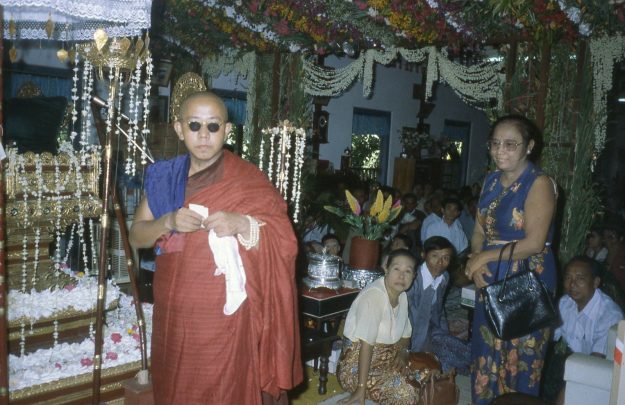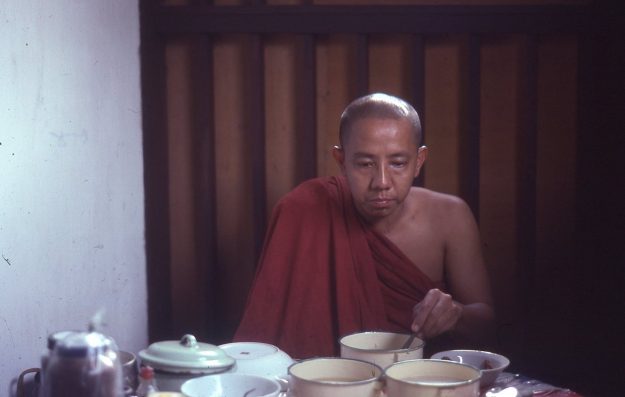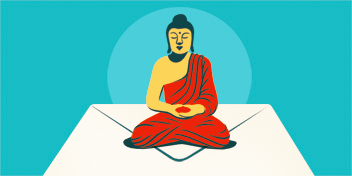I first met my teacher, Ahba, in 1983. At the time, he lived in a small wooden temple without electricity or running water in a remote part of northern Thailand. Ahba had just fled from his home of Myanmar, narrowly escaping the military dictatorship, or junta, who had come to arrest him due to his growing renown and influence as a venerated samatha meditation teacher in the country.
“Ahba” means father in Burmese. In Myanmar, he was known as the Mukyawann Sayadaw, revered for his knowledge on meditation and the Abhidhamma—the ancient Pali texts sometimes referred to as the ultimate teaching (paramattha desanà), or the Higher Teachings of the Buddha. Nowadays, Ahba is known as Luang Por Opart Obhaso, and his monastery in Thailand has grown to become one the best Pali schools in the country, yielding him a royal patronage.

Reading this, you might be inclined to conclude that studying ancient scriptures forms an integral part of Ahba’s teachings—but you would be wrong. Although the Pali suttas and Abhidhamma are a good and trustworthy source when it comes to the dharma, reading them with the desire to gain insight might not work out the way you hope. From the very beginning, Ahba has always placed the entire emphasis of his teachings on the practice of meditation above all else, specifically on the development of concentration, or samadhi.
Looking at the suttas, one will see the Buddha teaching the same thing. Have you ever read a sutta in which the Buddha gave a disciple the advice to go sit under a tree and study? I haven’t. On the contrary, the Buddha repeatedly and ardently tells his disciples to go meditate:
“These are the feet of trees, bhikkhus, these are empty huts. Meditate, bhikkhus, do not be negligent, lest you regret it later. This is my instruction to you.” (Saṁyutta Nikāya 35:145)
Of course, the Buddha gave discourses on more than just meditation, but contrary to our picking up a book or sutta of our own choosing, the Buddha was able to see exactly what his audience needed and adapt his teaching accordingly. So when the Buddha taught the dharma, it was always just right and always with the invitation to see for ourselves (often said as “ehipassiko,” which literally means “come and see for yourself”). And as one might infer, seeing for yourself does not mean reading, it means developing concentration:
“For a person whose mind is concentrated, it is not necessary to think ‘May I know and see things as they really are.’ It is the nature of things that a person whose mind is concentrated knows and sees things as they really are.” (Aṅguttara Nikāya 11:2)
In the end, you could read every book on Buddhism and every sutta and still know nothing, and you could do nothing but practice ardently and still know everything.
Catching a Fish
Ahba relates this lesson on the importance of developing one’s practice over reading ancient texts through the example of trying to catch a fish. If you study the suttas only with the hope of gaining insight, it is like trying to catch a fish in a very cloudy pond. The fish can’t see you nor can you see the fish—all you can do is move your hand haphazardly back and forth in the water, hoping to chance upon a fish. Maybe you’ll catch a fish, but maybe you won’t, and who knows how long it will take. With regard to studying the Abhidhamma, it is like trying to catch a fish in a very clear pond. You can see the fish, but the fish can also see you, and every time you think you can catch it, it slips through your hands.
When it comes to the works of other teachers—Western teachers, especially–Ahba used to gently remind me that it is difficult to see if what they have written is true or not. Only if you have meditated for a long time, and if you slowly start seeing things how they are, can you know what is true and what is not true. In the end, it is all about your own practice, your own patient effort to clean your own mind. Of course, this does not mean that reading is bad. It is perfectly fine if you find inspiration in a text or teaching, but just be sure to understand it for what it is, and do not confuse it with true insight or true knowledge.
In this regard, Ahba’s style of instruction closely matches that of some of the most famous Forest Tradition teachers, such as Ajahn Mun, Ajahn Sao, or Ajahn Chah. Later on in my practice, I found great delight in the teachings given by these famous meditation masters, translated by their Western students. In reading them, I was always reminded of Ahba guiding me on the path—sometimes gently, sometimes sternly, but always giving me exactly what I needed at those specific moments. Not only did these Ajahns recommend the same meditation object, “buddho,” but they also placed Buddhist meditation in the much wider context of everyday life—with a strong emphasis on personal experience over textual knowledge.
After reading their teachings, you can’t get around the importance of integrating morality and mindfulness into daily life as a prerequisite for calm and insight. Just look at this beautiful quote from one of Ajahn Chah’s teachings, from his book A Still Forest Pool (Quest Books, 2004):
“Try to be mindful and let things take their natural course. Then your mind will become still in any surroundings, like a clear forest pool. All kinds of wonderful, rare animals will come to drink at the pool, and you will clearly see the nature of all things. You will see many strange and wonderful things come and go, but you will be still. This is the happiness of the Buddha.”
If you want to free yourself, you have to put all your heart into your practice, patiently developing your mind every day—day in, day out—without desiring results or wisdom. This last part is very important. Ahba always warns his students that all desire—even the desire for wisdom—is the root cause of all our problems and suffering.
Ahba’s Advice
When it came to reading during one of my retreats at Ahba’s monastery, he was even more strict. “Don’t read,” he said. “If you read, you won’t get concentration.” I have found this to be very good advice. Reading activates the mind; you start thinking and evaluating, and before you know it, your meditation is about what you read instead of calming the mind and seeing things more clearly.
I took this principle as my sole working hypothesis until 2010 when, after thirty years of practice, Ahba called me into his house, or kuti, and gave me a life-altering bit of advice. During my retreat that year, Ahba told me to start studying the Abhidhamma, specifically Bhikkhu Bodhi’s book A Comprehensive Manual on Abhidhamma (Buddhist Publication Society, 1999). Ahba spoke about Bhikkhu Bodhi with great respect.
I had previously tremendously enjoyed Nyanaponika Thera’s Abhidhamma Studies (Wisdom Publications, 1998), which seemed to offer new perspectives on the dharma with every rereading, but it was during that retreat in 2010—combining long hours of meditation with the study of Bhikkhu Bodhi’s book—that, for the first time, I felt what I read had settled into my mind, as I understood the dharma on a new, much deeper level. I experienced what I read in the Abhidhamma to be a very true representation of the working of the mind and our universal experience of the world.
In the Abhidhamma, it is taught that the mind consists of separate moments of consciousness, each with their mental factors and conditioning forces that bind them together. It is the ultimate analysis of reality into its smallest building blocks and the synthesis of these building blocks into the stream of consciousness we experience. In its deepest sense, the Abhidhamma teaches that all of us are able to develop our minds, to slowly move our minds away from being chained by unwholesome mental states rooted in desire, hate, and ignorance, and toward wholesome mental states that lead to a blissful state or the freedom of nibbana.
Although what I read at that time had a great impact on my life, it was not so much the book itself that was the cause. I had read it before, falling asleep above its pages many times. It was all about the timing of what I read. To be precise, it was the result of my teacher’s ability to see exactly what would be most beneficial to me at that specific moment. This is what makes a true teacher, in my opinion, seeing the mind of the disciple and offering guidance—sometimes gently, sometimes sternly, but always with exactly what is needed at that specific moment.

Thank you for subscribing to Tricycle! As a nonprofit, we depend on readers like you to keep Buddhist teachings and practices widely available.

